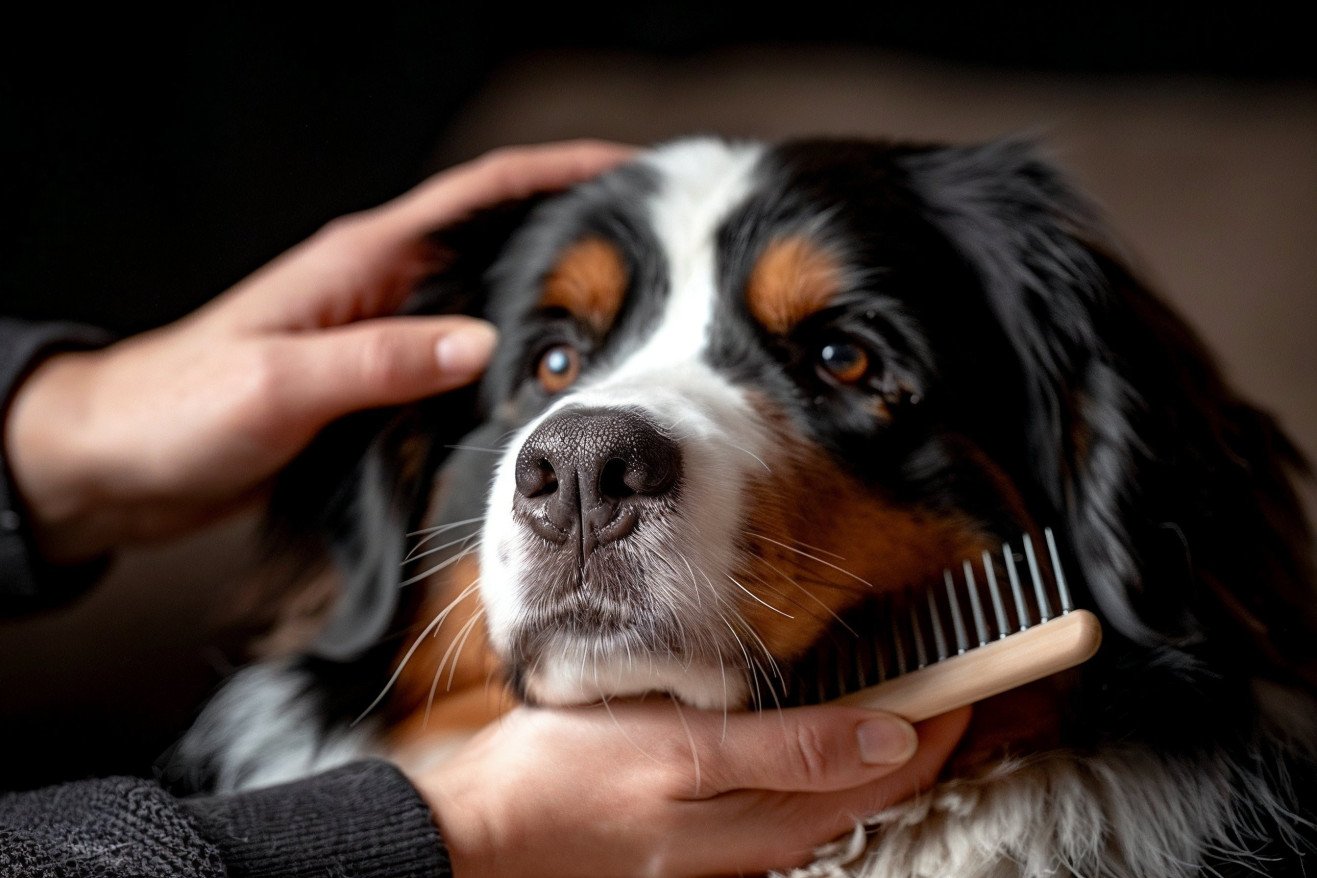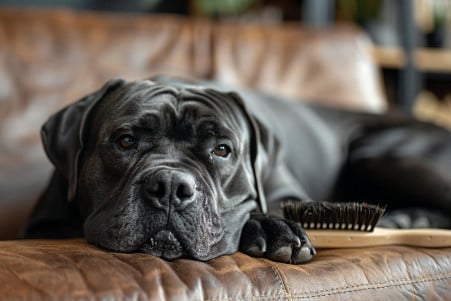Do Bernese Mountain Dogs Shed? Managing Your Berner’s Coat
20 February 2024 • Updated 19 February 2024

Known for their sweet temperaments, Bernese Mountain Dogs also come with a lot of hair. The answer to the question, “Do Bernese Mountain Dogs shed?” is a resounding yes, and it’s because of their long, double coat. Bernese Mountain Dogs have a medium level of shedding throughout the year, with heavier shedding in the spring and fall. However, their shedding can be managed with regular grooming and a healthy diet.
This article will cover a range of studies from dog genetics to veterinary medicine to explain why Bernese Mountain Dogs shed the way they do. It will look at the genetics behind their grooming needs, how their diet impacts their coat, and the genetic factors that make their fur so luxurious.
By looking at these different elements, the article will offer practical tips that you can use to keep shedding under control and ensure your Berner’s coat stays beautiful.
Do Bernese Mountain Dogs shed?
The Shedding Cycle of Bernese Mountain Dogs
Bernese Mountain Dogs have a unique shedding cycle that involves a moderate amount of shedding year-round. According to A-Z Animals, this friendly breed has a more extreme shedding cycle as they move through the year, with the most shedding happening in the spring and fall. Often called “blowing the coat,” this is when the Berner gets rid of its undercoat to either prepare for the summer or winter.
The undercoat is important in this cycle because it insulates the dog and changes with the temperature. As Love Your Dog explains, the breed’s history in the Swiss Alps meant that the undercoat was important for warmth, and the guard hairs protected against the elements. This means that the shedding cycle is most intense in the summer and winter when the Berner blows its undercoat to help regulate its body temperature.
The shedding cycle can also be impacted by the environment, including the weather. Bernese Mountain Dogs that live in areas with more extreme seasons will likely have more extreme shedding cycles than those in more temperate areas. This means that it’s important for owners to keep up with regular grooming to help the dog through this cycle and make sure they’re comfortable and healthy as they adjust to the weather.
Grooming Supplies for Bernese Mountain Dogs
In order to stay on top of Bernese Mountain Dog shedding, it’s important to have a regular grooming routine. According to AKC Pet Insurance, regular at-home grooming can help keep shedding under control.
For Bernese Mountain Dogs, who have a long, thick double coat, this means regular brushing with the right tools a few times a week. Rover recommends a few different tools, including the FURminator and a high-quality slicker brush, that can get through the topcoat and down to the undercoat to remove loose hair.
Rover also warns against shaving your Berner to avoid disrupting the natural insulating properties of their double coat, which could lead to the hair growing back in a strange pattern. Keep your dog’s coat in the best shape by brushing regularly in between professional grooming appointments and using detangling sprays to make the process easier.
With these grooming supplies as part of your regular routine, you can stay on top of shedding and keep your Bernese Mountain Dog’s coat looking and feeling its best. With the right care, you can make sure your dog’s coat is a reflection of their overall health and wellness.
The Role of Diet in Shedding and Coat Health
A diet that is full of essential nutrients is important for keeping the Bernese Mountain Dog’s coat looking and feeling its best while also keeping shedding to a minimum.
Studies have shown that protein is important for hair health and that dogs that don’t get enough high-quality protein in their diets are more likely to shed. Omega fatty acids, especially omega-3 and omega-6, are also important for a shiny coat and healthy skin.
Vitamins A and E and minerals like zinc help with skin oil production, hair follicle health, and protection against oxidative stress (Diamond Pet).
By making sure your dog’s diet includes these important nutrients, you can help reduce shedding and improve the overall health of their coat.
When looking for a high-quality dog food, dog owners should look for options that include real meat and whole foods to ensure that their dog gets the best nutrition without any fillers or byproducts.
By making sure that your Berner’s diet is tailored to their specific nutritional needs, you can help ensure that their coat stays healthy and vibrant. This will help your dog live a long, healthy life with a coat that looks as good as it feels.
Genetics of Bernese Mountain Dog Shedding
The Bernese Mountain Dog’s heavy shedding is due in part to genetic factors that are specific to the breed. Genes that control the hair follicle growth cycle, including the Fibroblast Growth Factor-5 (FGF5) gene variants, determine the Bernese Mountain Dog’s coat type and are associated with long hair phenotypes in dogs. Research published by PMC shows that these gene variants control coat length and may also be involved in shedding.
Genetic diversity, or the lack thereof, is another important genetic factor that impacts the health of the Bernese Mountain Dog’s coat. The Institute of Canine Biology found that a low median heterozygosity of 29.4% in the breed is a sign of low genetic diversity.
Inbreeding, which is common in the Bernese Mountain Dog, makes this lack of genetic diversity even worse, which can potentially impact the health of the breed’s coat. In addition, inbreeding can increase the likelihood of genetic diseases and may impact shedding due to the increased expression of certain coat-related traits.
Genetic factors are important to keep in mind when it comes to maintaining and improving coat health. While grooming and diet are important, the preservation and understanding of genetic diversity are key to ensuring the overall health of the Bernese Mountain Dog’s beautiful coat.
In Conclusion: What to Know About Bernese Mountain Dog Shedding
With their long, thick double coats, Bernese Mountain Dogs are definitely heavy shedders. However, as we’ve discussed, their shedding is moderate year-round and increases with the seasons, which is a direct result of the temperature changes their ancestors faced in the Swiss Alps.
As Love Your Dog explains, regular grooming is a must for these big dogs. Daily brushing during the heaviest shedding times, using the right tools, can help keep the hair in your home to a minimum.
Good nutrition is also important for healthy coats. As Animal Hearted explains, a diet that’s high in Omega fatty acids can help keep the skin healthy and may even reduce shedding. This, as well as the genetic factors we’ve already covered, can impact how much a Bernese Mountain Dog sheds and the condition of their coat.
By knowing these shedding patterns, grooming needs, nutritional requirements, and genetic influences, you can make sure your Berner’s coat lives up to the promise of their mountain dog heritage. With the right care, you can enjoy your Bernese Mountain Dog’s friendly, good-natured personality and beautiful looks without feeling overwhelmed by their shedding.


